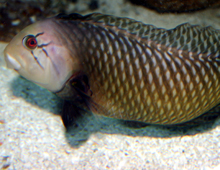Description: Dragon wrasses, also referred to as Rockmover wrassse, differentiate in appearance. As juveniles, this species presents a dainty appearance, with a lacy-looking pattern and fins. They are reddish or brown with white speckles and have long filamentous extensions on their fins. As they mature the elongated fins disappear. Adults are dark greenish brown with numerous white spots. They have brown bands that branch out from their eyes and a gray head. The fins are black, however, the dorsal and anal fins have light wavy lines and the tail fin has white at its base.
Size: Dragon wrasses reach a maximum size of 12 inches (30 cm).
Behavior: The formidable adults are powerful fish that work in teams, taking turns lifting rocks and grabbing the animals they find underneath to eat. These diurnal fish will bury themselves in the sand, hide in crevices or reef rubble when threatened and to sleep.
Diet: They eat small invertebrates (such as mussels, starfish, urchins, shrimp, etc) and tiny fish.
Senses: They rely on vision to locate prey.
Communication: Males display during mating season by spreading his fins and circling around a potential female mate.
Reproduction: After a courtship display, the male swims up into the water column followed by the female until they are side-by-side. Once they reach the peak of this ascent, they release their gametes. The spherical eggs are pelagic and float in the pelagic zone for about 75 days.
Habitat/range: This species is found in areas with sandy or rubble covered bottoms such as protected lagoons and reef edges. They inhabit the tropical and sub-tropical waters of the Indo-Pacific Region.
Status: Least Concern on IUCN Red List



